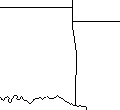Tulsa, OK
Weather Forecast Office
Summer Climatology for Eastern Oklahoma and Northwest Arkansas |
  |
Summertime in Eastern Oklahoma and Northwest Arkansas is a period of warm temperatures and varying amounts of humidity and rainfall. Average high temperatures range from the mid 80s in June near Fayetteville to the low to mid 90s in Tulsa, McAlester and Fort Smith in July and August. The region experiences several days of 100+ degree readings during a typical summer, and nights are usually mild with average lows in the 60s and lower 70s. The majority of summer precipitation falls from thunderstorms, and these storms are sometimes accompanied by large hail and strong winds along with occasional tornadoes. When summer thunderstorms do occur, they tend to be either in the late afternoon or during the early morning hours. Total rainfall in the summer months is less than during the spring and the area receives nearly 75% of the total possible sunshine.
US Dept of Commerce
National Oceanic and Atmospheric Administration
National Weather Service
Tulsa, OK
10159 E. 11th St. Suite 300
Tulsa, OK 74128
918-838-7838
Comments? Questions? Please Contact Us.

